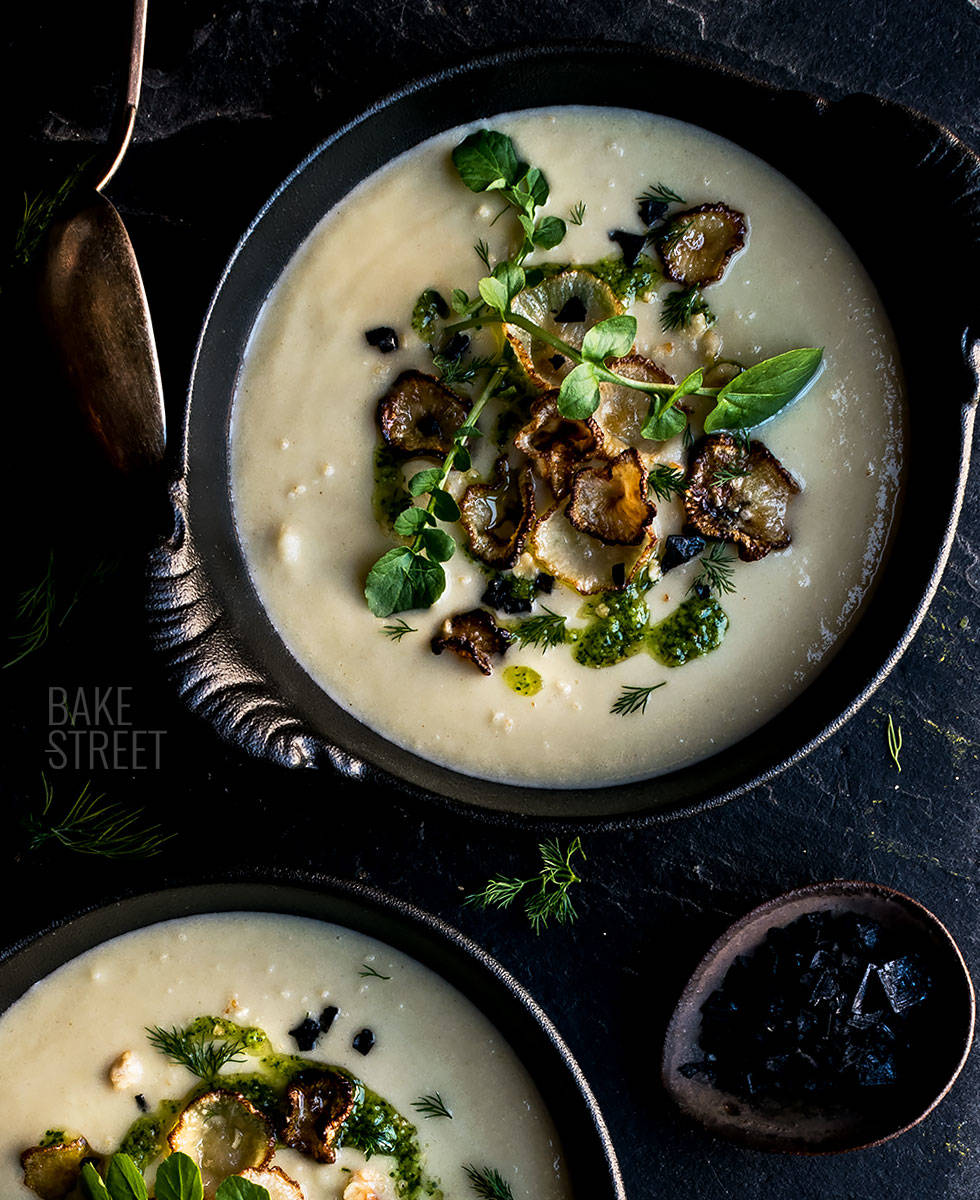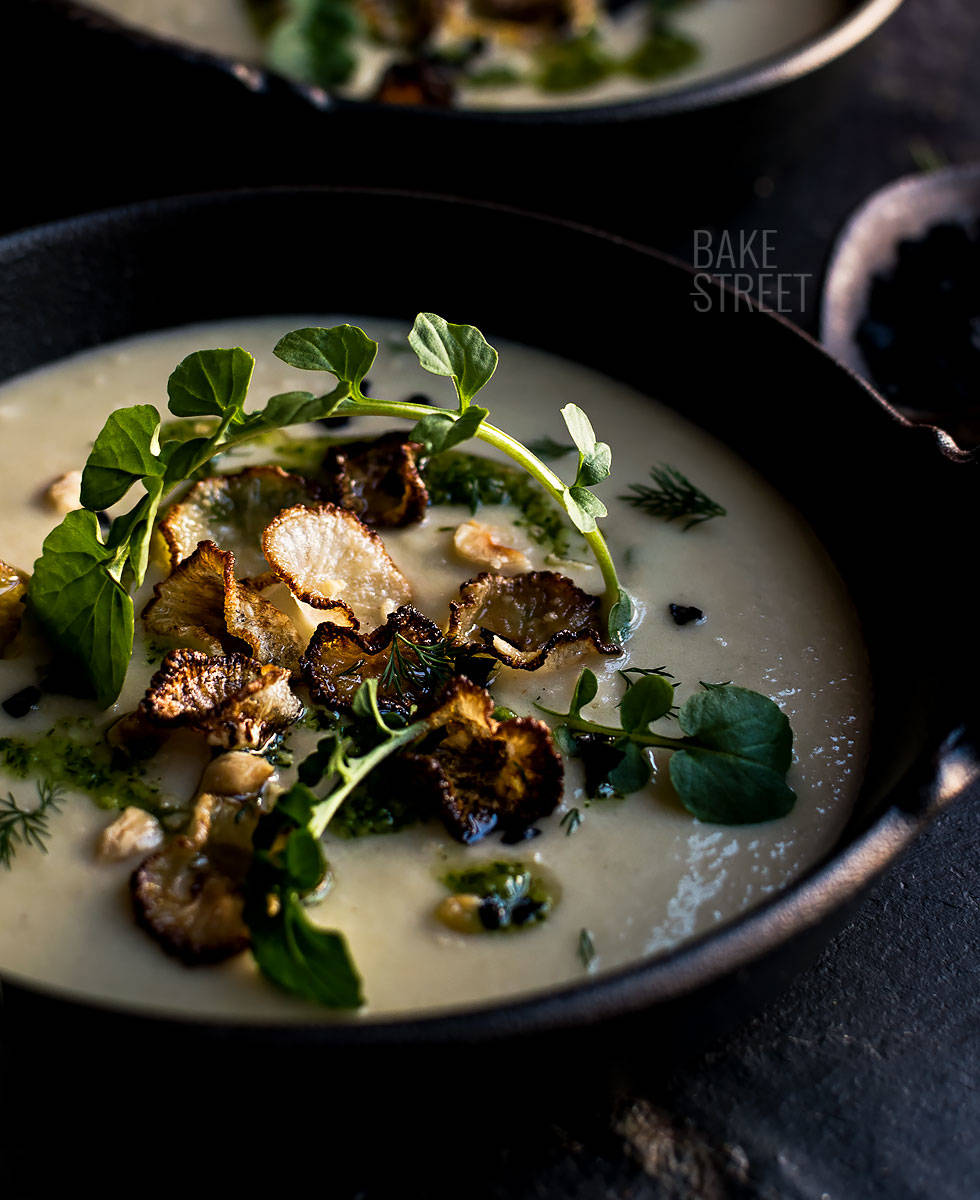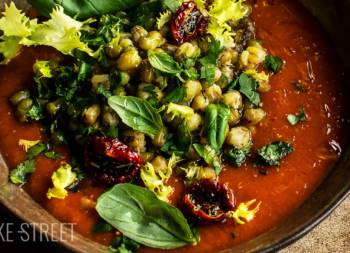
Jerusalem artichoke soup with pesto and daikon chips
It’s been a long time since I’ve left you any soup or cream. You know that every week I usually make them at home and, besides preparing some that we like very much, I like to try other new versions. Today’s recipe is based on one by Ottolenghi from his book The Nopi Cookbook, I really wanted to try it and I finally did. Jerusalem artichoke soup with pesto and daikon chips based on his famous Jerusalem artichoke soup with spinach and hazelnut pesto.
What can I tell you about this man that you don’t already know? For me, he’s an inspiration. I love his cuisine, his way of working and combining flavors, as well as the incredible originality of his recipes. He is always a point of reference in my kitchen and his books are the first ones I look at when I want to do different things at home.
Tupinambo or Jerusalem artichokes.
A few weeks ago I bought several ingredients in the fruit shop that are out of the ordinary, and among them I took tupinambos or also known as Jerusalem artichokes. I really wanted to try this soup a long time ago.

What is tupinambo?
It is a tuber originating in North America. Its interior is white with an exterior that may have shades ranging from brown to purple. It receives other names like aguaturma, earth chestnut, sweet potato of cane, criadilla de agua, sunflower of Canada...
Jerusalem artichoke arrived in Europe in the seventeenth century, the first plantations being cultivated in Paris in 1613. It was a very consumed food until the potato left it in the background. Its texture is very similar to that of the potato and its taste is reminiscent of the artichoke, but with sweet notes.
It has diuretic properties, making it a perfect ingredient for people suffering from rheumatism and fluid retention. Besides regulate the amount of sugar in the blood, is rich in fiber and minerals. It has a satiating effect and is a wonderful intestinal regulator thanks to the presence of inulin.
What is inulin?
It is a prebiotic fibre soluble in water that can be found in onions, garlic, asparagus, tupinambos and many other ingredients. These indigestible prebiotics encourage probiotics that, in turn, benefit the production of beneficial bacteria from our body forming the microbiota or intestinal flora. Inulin is converted into short-chain fatty acids (SFCAs), a product of prebiotic fermentation, and then transformed into healthy ketones that nourish your tissues. They can also nourish cells in the large intestine and produce hormones that control appetite.
These beneficial bacteria aid digestion and absorption of food by playing an important role in immune function as well as helping to prevent colon cancer.
Preparing tupinambo soup.
When preparing the soup you will only need to pay attention to it for the first few minutes. We will sautée some ingredients to finish with the joint cooking of all. Of those grateful plates that, almost, almost, are done alone. In my case I have chosen to make it with Dashi broth, which you can see how to do in this post, but can be made with any other type of broth. It’s very simple to make and you can enjoy a great first course.
At the time of serving it you can do it with what you like most. Its taste is very pleasant, fresh and mild, so it becomes a very versatile dish when it comes to combining it with other elements.
In my case I decided to make a watercress pesto with some dill, sage and hazelnuts to decorate the surface. In addition to using fresh watercress and daikon chips.
The soup can be eaten both hot and cold, making it ideal to eat at any time of year.

Ingredients for 6 serves
FOR THE SOUP:
- 700 g tupinambo or Jerusalem artichokes
- 1 large sweet onion
- 2 medium leeks
- 2 large garlic cloves
- 565 g Dashi broth (recipe)
- 2 Tbsp olive oil
- 265 g sweet white wine
- 250 g coconut milk
- salt to taste
FOR WATERCRESS AND HAZELNUT PESTO:
- 60 g watercress
- 8 g fresh dill
- 5 g fresh sage
- 18 g fresh ginger
- 90 g olive oil
- 40 g hazelnut oil
- 100 g Parmesan cheese
- 75 g roasted hazelnuts
- 8 g garlic
- white truffle salt to taste
- shichimi togarashi to taste
FOR GARNISH:
- watercress
- dill
- hazelnut oil + watercress pesto
- Daikon chips
- black salt
FOR DAIKON CHIPS:
- Daikon
- olive oil
- flaky salt
Instructions
Make the watercress and hazelnut pesto.
- Wash the watercress, sage and dill with cold water, dry carefully. Remove the broad stems from the dill and leave only the leaves.
- In a food processor or blender add the watercress together with the dill, the sage and the two types of oil. Blend until you get an intense green paste.
- Add hazelnuts together with the Parmesan cheese, the chopped fresh ginger and the garlic. Blend again until a homogeneous mixture is obtained.
- Taste and rectify salt if necessary. In my case I added white truffle salt.
- Add a pinch of shichimi and mix.
- Transfer the pesto into an airtight container, cover with olive oil and refrigerate until the time of use.
Make Jerusalem artichoke soup.
- Peel the Jerusalem artichokes and cut into very thin slices. This step is important because this ingredient takes a long time to cook.
- Wash the leeks very well with cold water and cut into slices. Set aside.
- Pour the olive oil into a medium saucepan and place at medium heat.
- Once it has a temperature, add the finely chopped sweet onion and cook for 2-3 minutes stirring from time to time.
- Add the leeks together with the garlic and cook for 5-6 minutes, stirring occasionally.
- Add artichokes together with a little salt and cook for 15 minutes. Stir from time to time to avoid sticking to the base.
- Pour in the sweet white wine and cook for 3-4 minutes. This should be reduced to approximately 1/4.
- Add the Dashi broth together with the coconut milk and heat to medium-high. Once it comes to a boil, reduce to low heat, with the lid on, but do not cover completely. Cook for 55-60 minutes.
- Stir from time to time and, at the end of cooking, check if artichokes are tender.
- Remove from the heat and blend.
- Stir and let stand 10-12 minutes.
Make Daikon chips.
- Cut a piece of Daikon, as much as we want, and peel.
- Wash with cold water and dry with kitchen paper.
- Using a mandolin and the thinnest cut, cut the daikon. Place the slices on absorbent kitchen paper. The reason is that it is an ingredient that contains a lot of water and we are interested in "drying" it a little before frying it.
- Once we have all the radish cut, pour 1 inch of olive oil, more or less, into a small frying pan and place at medium-high heat.
- Put daikon slices in the oil and fry for 30-40 seconds on each side. Or until golden brown.
- Carefully remove and place on kitchen paper to absorb excess oil.
- Repeat with all the daikon slices.
Serve.
- Mix 1-2 tablespoons of pesto with some hazelnut oil. In this way we will manage to lighten it, set aside.
- Ladle the soup in individual plates or bowls, to our choice.
- Spread hazelnut pesto on the surface.
- Decorate with daikon chips, hazelnuts, watercress, dill and black salt.
- Serve immediately.

Notes
- Tupinambo or Jerusalem artichokes need a lot of cooking time, so I recommend you cut them as thin as possible so as not to prolong the cooking too long.
- You can substitute the Dashi broth with another variety of broth such as vegetables, chicken... To your taste and choice.
- Remember to dry daikon slices before frying them. That way we'll prevent it from jumping when we're frying them.

- Coconut milk gives it a special flavour and a very creamy texture. But it can be replaced for whole cow's milk if you wish or even another variety of vegetable milk.
- The pesto can be this variety that I leave you or any other, even the traditional one elaborated only with basil and pine nuts. In the blog you can also find a "arugula, basil and almonds pesto", "sage and hazelnuts pesto" and another of "kale" (this only available in Spanish)
- The decoration is totally to your choice, in my case I have left you this suggestion, but feel free to change it.
- The soup can be frozen in an airtight container or kept refrigerated for 3 days.

This Jerusalem artichokes soup with pesto and daikon chips has undoubtedly become another of our favorites. I've always been crazy about soups and creams, I love them and I can't stop making them at home. But, if there's one thing I like to do it's to be able to combine the light consistency of it with solid or crunchy elements in its decoration.
I love to enjoy each spoonful and find different textures and contrasts. That's why I always accompany each dish with a bowl full of toppings chosen to add more!
I wish you a wonderful beginning of the week.
Big hugs,
Eva
Sources: Mercola, Ecoagricultor
This post contains affiliate links.





